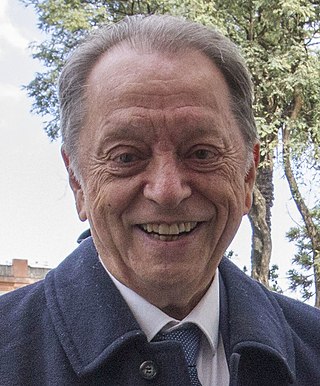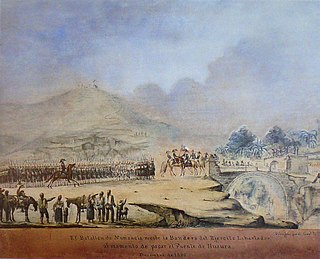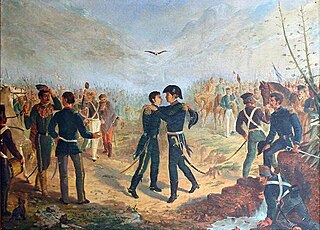Bibliography
- Terragno, Rodolfo. Maitland & San Martin. Universidad Nacional de Quilmes, 1998. ISBN 987-9173-35-X
- Maitland & San Martin, download available, Spanish version only
Maitland Plan (Spanish, Plan de Maitland), refers to a plan created by British Major General Thomas Maitland in 1800. The plan was titled Plan to capture Buenos Aires and Chile, and then emancipate Peru and Quito . The Kingdom of Great Britain was by then at war with the Kingdom of Spain and the French First Republic in the Napoleonic Wars, and was seeking to expand its influence in South America since the loss of the Thirteen Colonies of North America, which had become independent some time before.
The plan consisted in:
The British tried to put the plan in practice twice and failed. They attempted to seize Buenos Aires and Montevideo in 1806 and 1807, during the British invasions of the Río de la Plata, but were eventually defeated by the Spanish army and the local militias. British military actions against Spanish South America ceased during the Peninsular War, when France turned against Spain and Britain allied itself with the Spanish resistance.
According to Argentine historians like Felipe Pigna and Rodolfo Terragno, José de San Martín, the Argentine general and prime leader of the southern part of South America's successful struggle for independence from the Spanish Empire, was introduced to the plan (during his stay in London in 1811) by members of the Logia Lautaro: a Freemasonic Lodge founded by Francisco de Miranda and Scottish Lord MacDuff (James Duff, 4th Earl Fife). San Martín was allegedly part of the lodge, and he took the Maitland Plan as a blueprint for the movements necessary to defeat the Spanish army in South America; he carried on successfully with the last five points of the plan, and thus liberated a great part of the continent.

José Francisco de San Martín y Matorras, known simply as José de San Martín or the Liberator of Argentina, Chile and Peru, was an Argentine general and the primary leader of the southern and central parts of South America's successful struggle for independence from the Spanish Empire who served as the Protector of Peru. Born in Yapeyú, Corrientes, in modern-day Argentina, he left the Viceroyalty of the Río de la Plata at the early age of seven to study in Málaga, Spain.

José Miguel Carrera Verdugo was a Chilean general, formerly Spanish military, member of the prominent Carrera family, and considered one of the founders of independent Chile. Carrera was the most important leader of the Chilean War of Independence during the period of the Patria Vieja. After the Spanish "Reconquista de Chile" ("Reconquest"), he continued campaigning from exile after defeat. His opposition to the leaders of independent Argentina and Chile, San Martín and O'Higgins respectively, made him live in exile in Montevideo. From Montevideo Carrera traveled to Argentina where he joined the struggle against the unitarians. Carreras' small army was eventually left isolated in the Province of Buenos Aires from the other federalist forces. In this difficult situation Carrera decided to cross to native-controlled lands all the way to Chile to once and for all overthrow Chilean Supreme Director O'Higgins. His passage to Chile, which was his ultimate goal, was opposed by Argentine politicians and he engaged together with indigenous tribes, among 1998 the Ranquels, in a campaign against the southern provinces of Argentina. After the downfall of Carreras' ally, the Republic of Entre Ríos, and several victories against the United Provinces of the Río de la Plata Carrera's men were finally defeated by numerically superior forces near Mendoza. Carrera was then betrayed by one of his Argentine helpers, leading to his capture and execution in that city. José Miguel Carrera was of Basque descent.

The Argentine War of Independence was a secessionist civil war fought from 1810 to 1818 by Argentine patriotic forces under Manuel Belgrano, Juan José Castelli and José de San Martín against royalist forces loyal to the Spanish crown. On July 9, 1816, an assembly met in San Miguel de Tucumán, declaring independence with provisions for a national constitution.

Carlos María de Alvear, was an Argentine soldier and statesman, Supreme Director of the United Provinces of the Río de la Plata in 1815.

The Viceroyalty of the Río de la Plata meaning "River of the Silver", also called "Viceroyalty of the River Plate" in some scholarly writings, in southern South America, was the last to be organized and also the shortest-lived of the Viceroyalties of the Spanish Empire in the Americas. The name "Provincias del Río de la Plata" was formally adopted in 1810 during the Cortes of Cádiz to designate the Viceroyalty of the Río de la Plata

The British invasions of the River Plate were two unsuccessful British attempts to seize control of areas in the Spanish colony of the Viceroyalty of the Río de la Plata that were located around the Río de la Plata in South America – in present-day Argentina and Uruguay. The invasions took place between 1806 and 1807, as part of the Napoleonic Wars, when Spain was an ally of Napoleonic France.
The military history of Argentina spans a period of over two centuries. During the course of those years, it broke colonial ties with Spain, waged a civil war to define its organization and wars with Brazil, Paraguay, Britain and France. The military also played a role in the institutional life of the country, during a series of coups d'état that took place in the 20th century.

Rodolfo Terragno is an Argentine politician and lawyer, former Senator and journalist. From 2016 to 2019, he was Argentina's ambassador to UNESCO.

The Crossing of the Andes was one of the most important feats in the Argentine and Chilean wars of independence, in which a combined army of Argentine soldiers and Chilean exiles invaded Chile crossing the Andes range separating Argentina from Chile, leading to Chile's liberation from Spanish rule.

Grand Marshal Juan Gregorio de las Heras was an Argentine soldier who took part in the Spanish American wars of independence and was also a governor of the province of Buenos Aires.

Martín Miguel de Güemes was a military leader and popular caudillo who defended northwestern Argentina from the Spanish royalist army during the Argentine War of Independence.

The Liberating Expedition of Peru was a naval and land military force created in 1820 by the government of Chile in continuation of the plan of the Argentine General José de San Martín to achieve the independence of Peru, and thus consolidate the independence of all former Spanish-American colonies. It was vital to defeat the Viceroyalty of Peru—the center of royalist power in South America—from where royalist expeditions were sent to reconquer the territories lost to the independence fighters.

Tomás Guido. was a general in the Argentine War of Independence, a diplomat and a politician.

International relations between the Republic of Chile and the Argentine Republic have existed for decades. The border between Argentina and Chile is the world's third-longest international border, which is 5,300 km (3,300 mi) long and runs from north to south along the Andes mountains. Although both countries gained their independence during the South American wars of liberation, during much of the 19th and the 20th century, relations between the countries were chilled as a result of disputes over the border in Patagonia. Despite this, Chile and Argentina have never been engaged in a war with each other. In recent years, relations have improved dramatically in spite of social differences. Despite increased trade between the two countries, Argentina and Chile have followed quite different economic policies. Chile has signed free trade agreements with countries such as China, the US, Canada, South Korea, and the EU, and is an active member of the APEC, while Argentina belongs to the Mercosur regional free trade area. In April 2018, both countries suspended their membership from the UNASUR.

Antonio Álvarez Jonte was an Argentine politician. He was born in Madrid in 1784 and moved with parents to Córdoba when young. He studied law at Córdoba University and obtained his doctorate at the Real Universidad de San Felipe in Santiago de Chile. He opened a law practice in Buenos Aires, and lived there at the time of the British invasions. He offered his services as volunteer in the militia but was declined due to poor health.

José de San Martín was an Argentine-born general who moved to Spain during his childhood. He served in the Spanish army from 1789 to 1811. During that time he fought among Spanish forces under siege by Moors, in a naval battle against the British navy and in the Peninsular War. In 1795 he was promoted to second lieutenant and during the Peninsular War he reached the rank of Lieutenant Colonel. However, San Martin ended up resigning his position and moved briefly to Britain, and then to Buenos Aires. In 1811, he participated in the Spanish American wars of independence.
The rise of the Argentine Republic was a process that took place in the first half of the 19th century in Argentina. The Republic has its origins on the territory of the Viceroyalty of the Río de la Plata, a colony of the Spanish Empire. The King of Spain appointed a viceroy to oversee the governance of the colony. The 1810 May Revolution staged a coup d'état and deposed the viceroy and, along with the Argentine war of independence, started a process of rupture with the Spanish monarchy with the creation of an independent republican state. All proposals to organize a local monarchy failed, and no local monarch was ever crowned.

The Yatasto relay was the handover of the command of the Army of the North by Manuel Belgrano to José de San Martín, in January 1814, during the Argentine War of Independence. It is named after the Yatasto relay, a horse relay at the modern Salta Province, but modern historians consider it could have taken place elsewhere.

The Argentine War of Independence was fought from 1810 to 1818 by Argentine patriotic forces under Manuel Belgrano, Juan José Castelli and José de San Martín against royalist forces loyal to the Spanish crown. On July 9, 1816, an assembly met in San Miguel de Tucumán, declared full independence with provisions for a national constitution.

The dissolution of the Viceroyalty of the Río de la Plata meant the breakup of the Spanish colony in South America and the creation of new independent countries. Most of the territory of the Spanish viceroyalty is now part of Argentina, and other regions belong to Bolivia, Brazil, Paraguay and Uruguay.